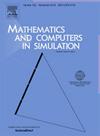Stochastic SIR epidemic model dynamics on scale-free networks
IF 4.4
2区 数学
Q1 COMPUTER SCIENCE, INTERDISCIPLINARY APPLICATIONS
引用次数: 0
Abstract
This study introduces a stochastic SIR (Susceptible–Infectious–Recovered) model on complex networks, utilizing a scale-free network to represent inter-human contacts. The model incorporates a threshold parameter, denoted as , which plays a decisive role in determining whether the disease will persist or become extinct. When , the disease exhibits exponential decay and eventually disappear. Conversely, when , the disease persists. The critical case of is also examined. Furthermore, we establish a unique stationary distribution for . Our findings highlight the significance of network topology in modeling disease spread, emphasizing the role of social networks in epidemiology. Additionally, we present computational simulations that consider the scale-free network’s topology, offering comprehensive insights into the behavior of the stochastic SIR model on complex networks. These results have substantial implications for public health policy, disease control strategies, and epidemic modeling in diverse contexts.
无标度网络上的随机 SIR 流行病模型动力学
本研究在复杂网络上引入了一个随机 SIR(易感-传染-复发)模型,利用无标度网络来表示人类之间的接触。该模型包含一个阈值参数(用 Rσ 表示),它在决定疾病是持续存在还是灭绝方面起着决定性作用。当 Rσ<1 时,疾病呈指数衰减并最终消失。相反,当 Rσ>1 时,疾病持续存在。我们还研究了 Rσ=1 的临界情况。我们的研究结果突出了网络拓扑在模拟疾病传播中的重要性,强调了社会网络在流行病学中的作用。此外,我们还提出了考虑无标度网络拓扑结构的计算模拟,为随机 SIR 模型在复杂网络中的行为提供了全面的见解。这些结果对公共卫生政策、疾病控制策略和不同背景下的流行病建模具有重要意义。
本文章由计算机程序翻译,如有差异,请以英文原文为准。
求助全文
约1分钟内获得全文
求助全文
来源期刊

Mathematics and Computers in Simulation
数学-计算机:跨学科应用
CiteScore
8.90
自引率
4.30%
发文量
335
审稿时长
54 days
期刊介绍:
The aim of the journal is to provide an international forum for the dissemination of up-to-date information in the fields of the mathematics and computers, in particular (but not exclusively) as they apply to the dynamics of systems, their simulation and scientific computation in general. Published material ranges from short, concise research papers to more general tutorial articles.
Mathematics and Computers in Simulation, published monthly, is the official organ of IMACS, the International Association for Mathematics and Computers in Simulation (Formerly AICA). This Association, founded in 1955 and legally incorporated in 1956 is a member of FIACC (the Five International Associations Coordinating Committee), together with IFIP, IFAV, IFORS and IMEKO.
Topics covered by the journal include mathematical tools in:
•The foundations of systems modelling
•Numerical analysis and the development of algorithms for simulation
They also include considerations about computer hardware for simulation and about special software and compilers.
The journal also publishes articles concerned with specific applications of modelling and simulation in science and engineering, with relevant applied mathematics, the general philosophy of systems simulation, and their impact on disciplinary and interdisciplinary research.
The journal includes a Book Review section -- and a "News on IMACS" section that contains a Calendar of future Conferences/Events and other information about the Association.
 求助内容:
求助内容: 应助结果提醒方式:
应助结果提醒方式:


